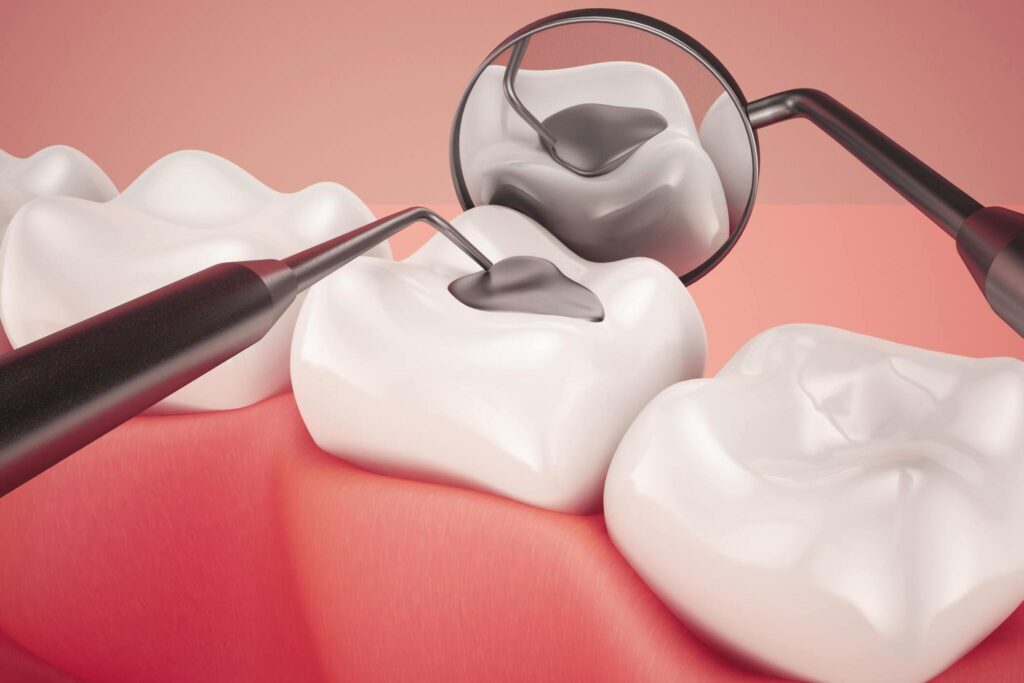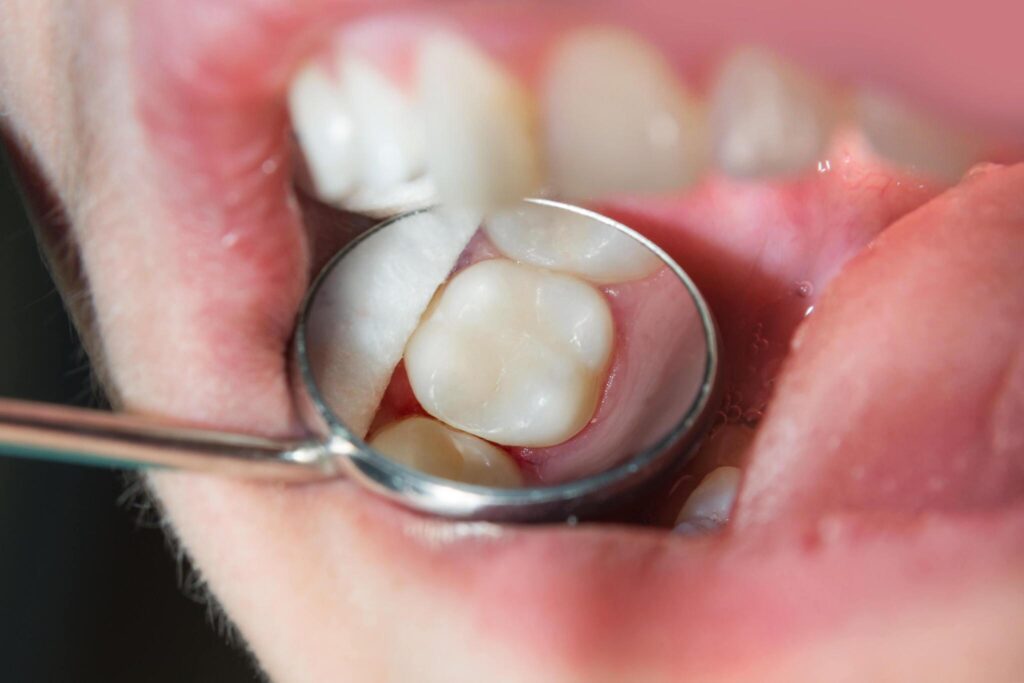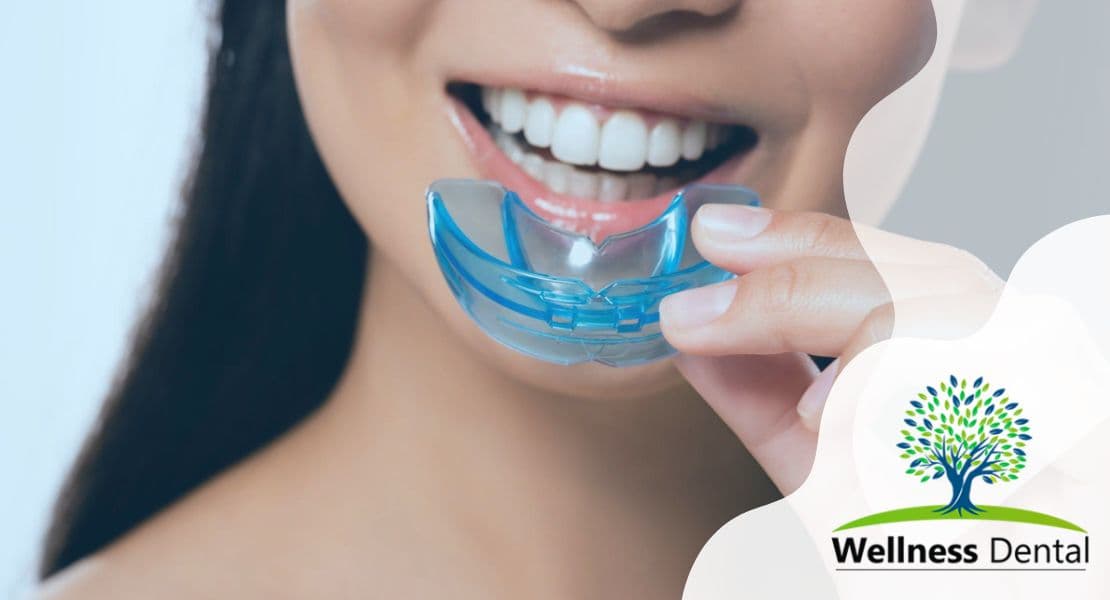Composite fillings are commonly used to repair decayed or damaged teeth, but patients should be aware of potential risks. One potential risk is tooth sensitivity which can occur when the composite material expands and contracts with temperature changes, causing discomfort and pain in the affected tooth.
Another consideration is the possibility of composite fillings cracking over time, particularly if they experience excessive force from chewing or grinding. As a result, further dental procedures may be required to fix or replace the filling.
Allergic reactions to the materials used in composite fillings are also a potential danger for some individuals, causing inflammation and discomfort in the mouth.
Furthermore, there are concerns over the cytotoxicity of the composite material, as some studies have shown that resin-based materials used in composite fillings can release toxic substances that may hurt oral health.
When evaluating the safety of composite fillings, factors to consider include the type of materials used, the quality of the light curing unit, and the skill of the dentist performing the procedure. Patients need to discuss these potential dangers with their dentist and weigh the risks and benefits before opting for composite fillings.
Are composite fillings harmful?

Composite fillings are a popular choice for dental treatment due to their natural appearance and durability. However, concerns have been raised about their potential toxicity.
A 2012 study found that the color of composite fillings can affect the release of substances that could be toxic to the body. Additionally, the use of light curing units to harden the fillings has raised some safety concerns.
To determine if composite fillings are the right choice for dental treatment, it is essential to consider the individual’s specific needs and concerns. Factors such as allergies, sensitivities, and the location and size of the filling should be taken into account. It is also important to discuss any potential safety concerns with a qualified dentist before proceeding with treatment.
Ultimately, while the potential toxicity of composite fillings is a valid concern, when used appropriately and with consideration of individual factors, they can still be a safe and effective option for dental treatment. It is crucial to have an open and informed discussion with a dental professional to determine the best course of action.
Do composite fillings affect health?

Composite fillings, composed of a mixture of plastic and glass, have been linked to potential health problems. One major concern is the exposure to Bisphenol-A (BPA), a chemical found in some composite resins. BPA is a known endocrine disruptor and has been associated with various health issues, including reproductive and developmental problems. Furthermore, individuals may also experience allergic reactions to the materials used in composite fillings, leading to oral discomfort and inflammation.
To determine the BPA level in composite resin, it is important to discuss with the dentist and inquire about the specific materials being used. It may also be beneficial to seek out composite fillings that are BPA-free to reduce the risk of exposure. Furthermore, individuals should communicate any severe health issues, such as allergies or sensitivities, with their dentist before the procedure to ensure the materials used are safe and suitable for their individual needs.
In conclusion, while composite fillings are a popular choice for dental restorations, there are potential health risks associated with BPA exposure and allergic reactions. It is crucial to have an open discussion with the dentist to address any concerns and choose the most appropriate materials for a safe and successful dental procedure.
What is considered the safest dental filling material?
The safest dental filling materials are composite resin, porcelain, and glass ionomer. These options are BPA-free and fluoride-free, making them the ideal choice for those concerned about potential health risks associated with these substances.
Composite resin is a popular choice for dental fillings due to its natural appearance and bonding capabilities. Porcelain, on the other hand, is known for its durability and biocompatibility, making it a safe option for dental restorations. Glass ionomer is also a BPA-free and fluoride-free material that can be used for dental fillings, especially in areas with high decay risk.
These materials satisfy biocompatibility standards, meaning they are well-tolerated by the body and do not cause adverse reactions or long-term health concerns. This makes them the safest options for dental fillings, particularly for individuals with sensitivities to certain chemicals or substances.
Patients can feel confident in choosing these materials for their dental restorations, knowing that they are free from potentially harmful compounds and have been extensively tested for biocompatibility.
Composite fillings procedure
The process of getting a composite filling involves several steps:
1. Shade Selection: The first step is selecting the shade of the composite material that best matches the natural color of the tooth.
2. Numbing the Tooth: Local anesthesia is administered to numb the tooth and the surrounding area to ensure the patient’s comfort during the procedure.
3. Tooth Preparation: The decayed or damaged part of the tooth is drilled out to create space for the composite material.
4. Bonding: The filling material is then bonded to the tooth using a special adhesive to ensure a strong and durable attachment.
5. Layering the Composite Material: The composite material is applied in layers, with each layer being hardened using a curing light before the next layer is added.
6. Shaping the Tooth: Once the filling material is layered and cured, it is shaped to match the natural contours of the tooth.
7. Checking the Bite: The dentist will check the patient’s bite to ensure that the filling does not interfere with the natural bite pattern.
Throughout the procedure, the use of local anesthesia ensures that the patient does not experience any pain or discomfort. The process of drilling, bonding, and curing is essential in creating a secure and long-lasting composite filling.
What is the lifespan of composite fillings?
Composite fillings typically have a lifespan of 7–10 years, based on research studies. However, the longevity of composite fillings can be affected by various factors such as the size and location of the filling, the patient’s oral hygiene habits, and the biting force exerted on the filling. Additionally, composite fillings placed in areas of high stress or constant grinding may wear out more quickly.
Composite resin fillings are primarily composed of a mixture of plastic and glass or ceramic materials. While they are generally considered safe, some concerns have been raised about the potential toxicity of composite resin fillings due to the presence of bisphenol A (BPA) and other potentially toxic materials. BPA is a chemical that has been linked to various health issues, although the amount present in composite fillings is typically very small.
To ensure safety and biocompatibility, composite resin fillings should not contain any harmful materials such as BPA, heavy metals, or other toxic substances. Patients need to discuss any concerns about the composition of their dental fillings with their dentist to ensure that they are receiving the safest and most suitable option for their oral health.
FAQ
Can composite fillings cause health problems?
Composite fillings are a commonly used dental material for restoring decayed or damaged teeth. They are considered safe and well-tolerated by the body, with no known adverse reactions or long-term health concerns. This makes them a suitable option for individuals who may have sensitivities to certain chemicals or substances. Extensive testing has been conducted to ensure their biocompatibility, giving patients confidence in choosing these materials for their dental fillings.
What are the disadvantages of composite fillings?
While composite fillings are a popular choice for dental restorations, they do come with some disadvantages. One of the main disadvantages is their lifespan. Composite fillings typically have a shorter lifespan compared to other types of fillings, such as amalgam or porcelain fillings. Research studies suggest that composite fillings may last 7-10 years before they may need to be replaced. This can be attributed to factors such as the size and location of the filling, oral hygiene habits, and biting forces exerted on the filling.
What is the safest tooth-filling material?
When it comes to choosing the safest tooth-filling material, there are several options available. One commonly used material is amalgam, also known as silver fillings. Amalgam fillings have been used for many years and are known for their durability and strength. However, they contain a small amount of mercury, which has raised concerns about potential adverse health effects.
What is the survival rate of composite filling?
Composite fillings have become a popular choice for dental restorations due to their natural appearance and ability to bond directly to the tooth structure. However, it is important to understand the expected lifespan of composite fillings and any potential risks associated with their use.
Research studies suggest that composite fillings typically have a lifespan of 7-10 years. However, this duration can vary depending on various factors. The size and location of the filling play a role in its longevity, as larger fillings may be subject to more wear and tear over time.
Do composite fillings weaken teeth?
Composite fillings are a widely used dental material for restoring decayed or damaged teeth. They are considered safe and well-tolerated by the body, with no known adverse reactions or long-term health concerns. This makes them a suitable option for individuals who may have sensitivities to certain chemicals or substances.
However, like any dental material, composite fillings do come with some disadvantages. One of the main drawbacks is their lifespan, which is typically shorter compared to other types of fillings such as amalgam or porcelain fillings.
What is better than a composite filling?
There are several alternatives to composite fillings that patients can consider. One option is amalgam fillings, also known as silver fillings. These have been used for many years and are known for their durability and strength. Amalgam fillings contain a mixture of metals, including mercury, which has raised concerns about potential adverse health effects. However, extensive research has shown that the levels of mercury released from amalgam fillings are generally considered safe.
Can you eat on composite fillings?
Composite fillings are a popular choice for dental restorations due to their natural appearance and ability to bond directly to the tooth structure. Many individuals wonder if it is safe to eat on composite fillings. The good news is that composite fillings are designed to withstand normal biting and chewing forces, allowing individuals to eat without concern.
Unlike certain types of restorative materials, such as porcelain or glass ionomer, composite fillings are known for their strength and durability. They can withstand the pressure exerted during eating without fracturing or breaking.
What are the long-term effects of fillings?
The long-term effects of fillings, specifically amalgam or silver fillings, have been a topic of concern for some individuals. Amalgam fillings contain a small amount of mercury, which has raised questions about potential adverse health effects. However, extensive research has shown that the levels of mercury released from amalgam fillings are generally considered safe.
Can a composite filling be removed?
Composite fillings, also known as tooth-colored fillings, are commonly chosen for dental restorations because of their natural look and ability to bond to the tooth structure. However, there may be situations where a composite filling will need to be taken out.
Removing a composite filling is possible and can be done by a dentist. The process involves carefully drilling away the existing filling material until it is completely removed from the tooth. This requires skill and precision to avoid damaging the surrounding tooth structure.
What is the strongest filling?
When it comes to dental fillings, individuals often wonder which type is the strongest. While there are several options available, each with its own advantages and disadvantages, some fillings are known for their durability and strength.
Amalgam fillings, also referred to as silver fillings, have been used for many years and are recognized for their exceptional strength. These fillings consist of a mixture of metals, including mercury. Although concerns have been raised about the potential adverse health effects of mercury, extensive research has shown that the levels released from amalgam fillings are generally considered safe.






